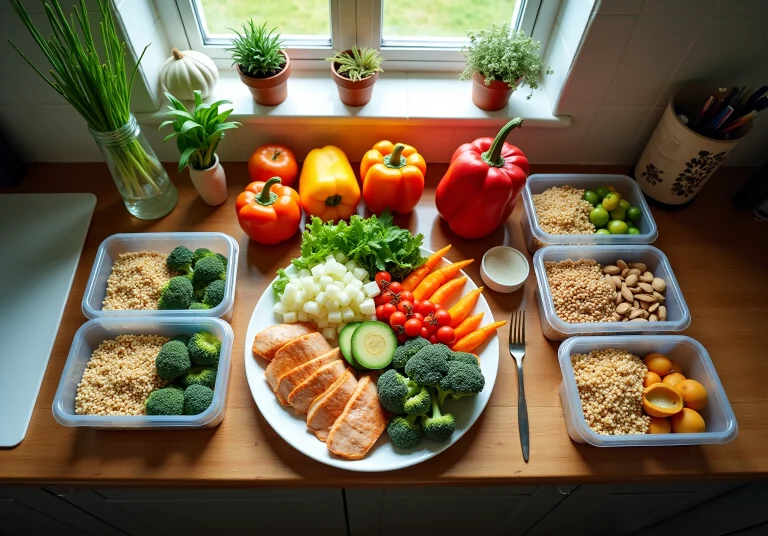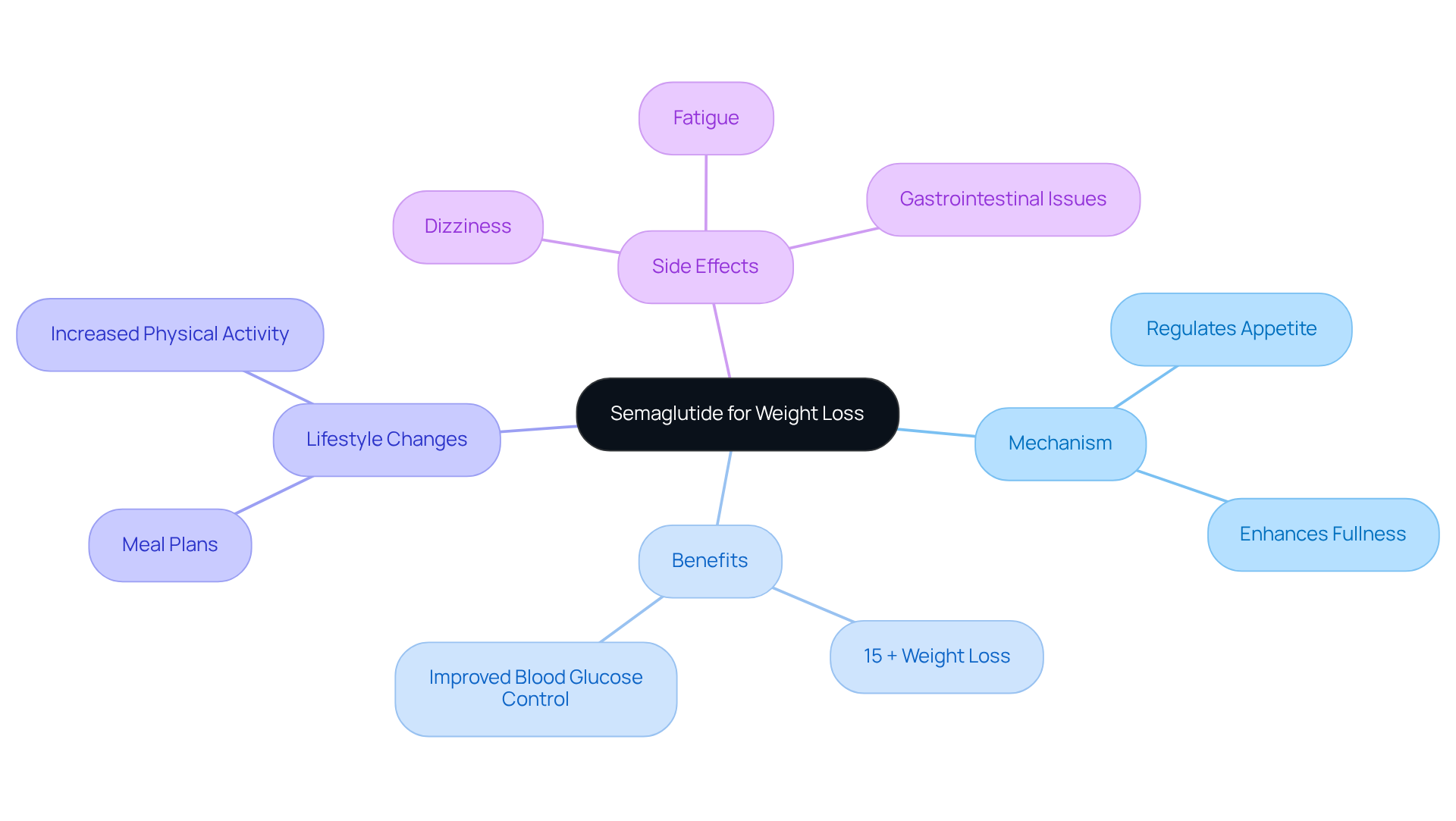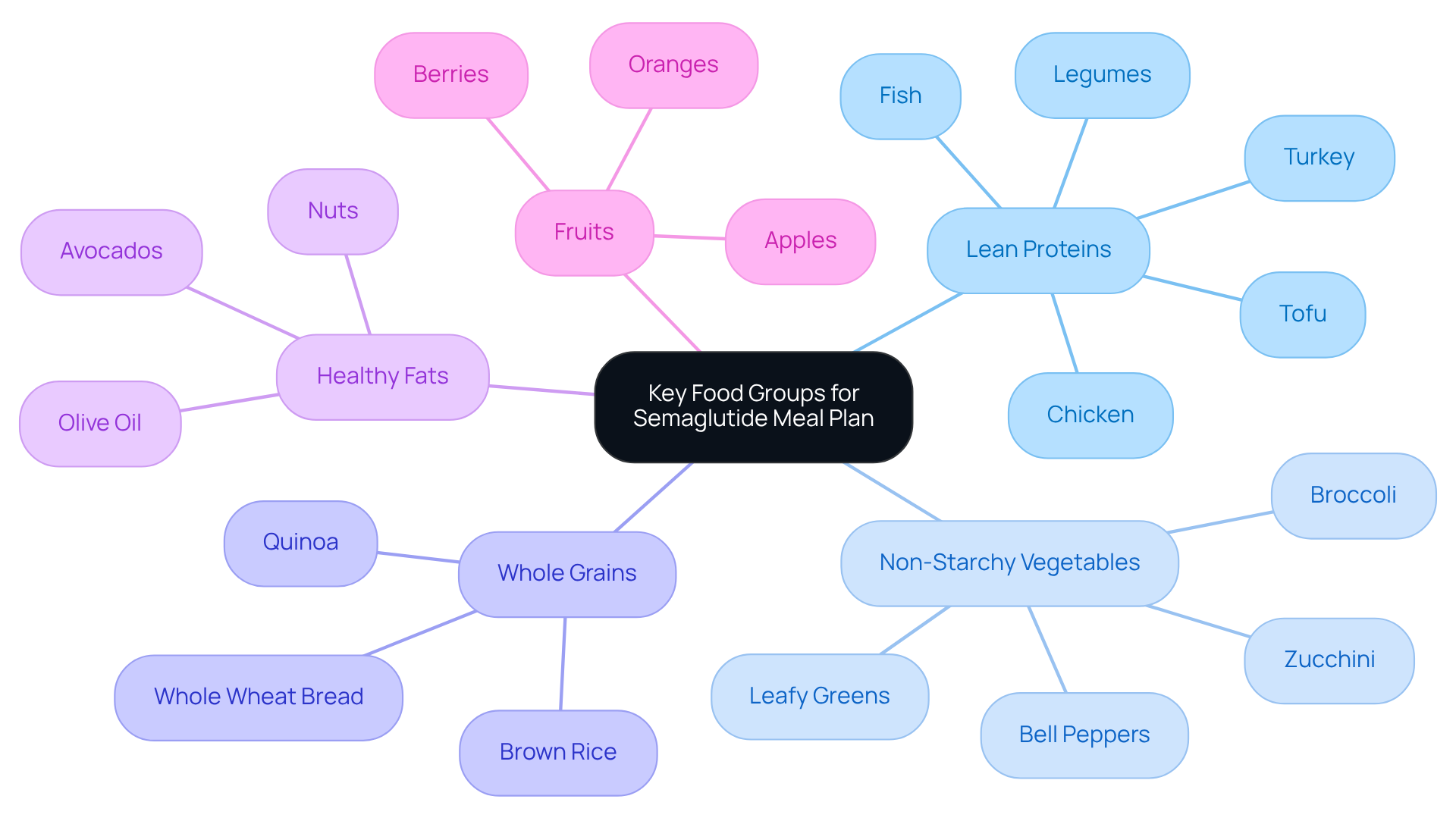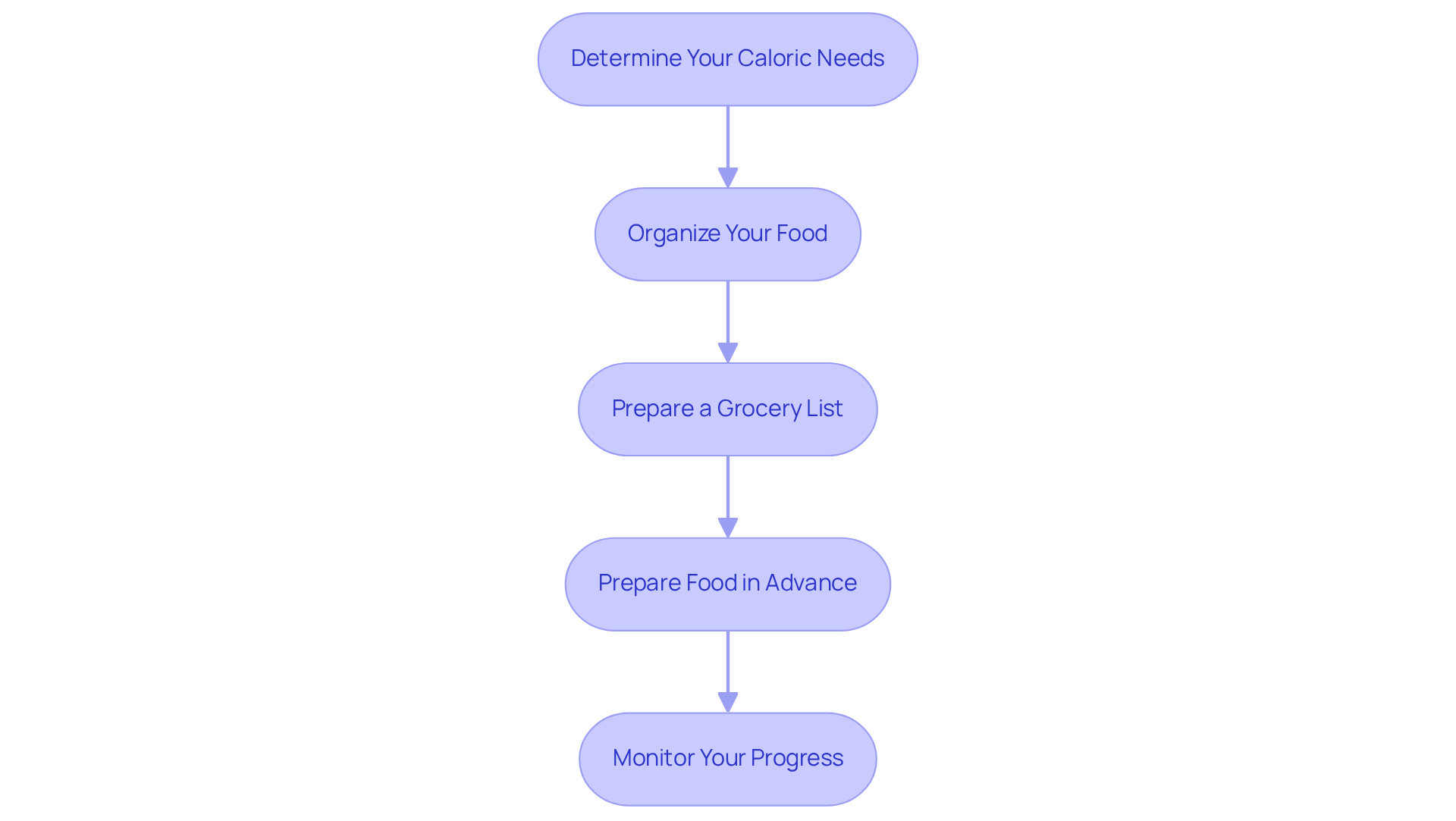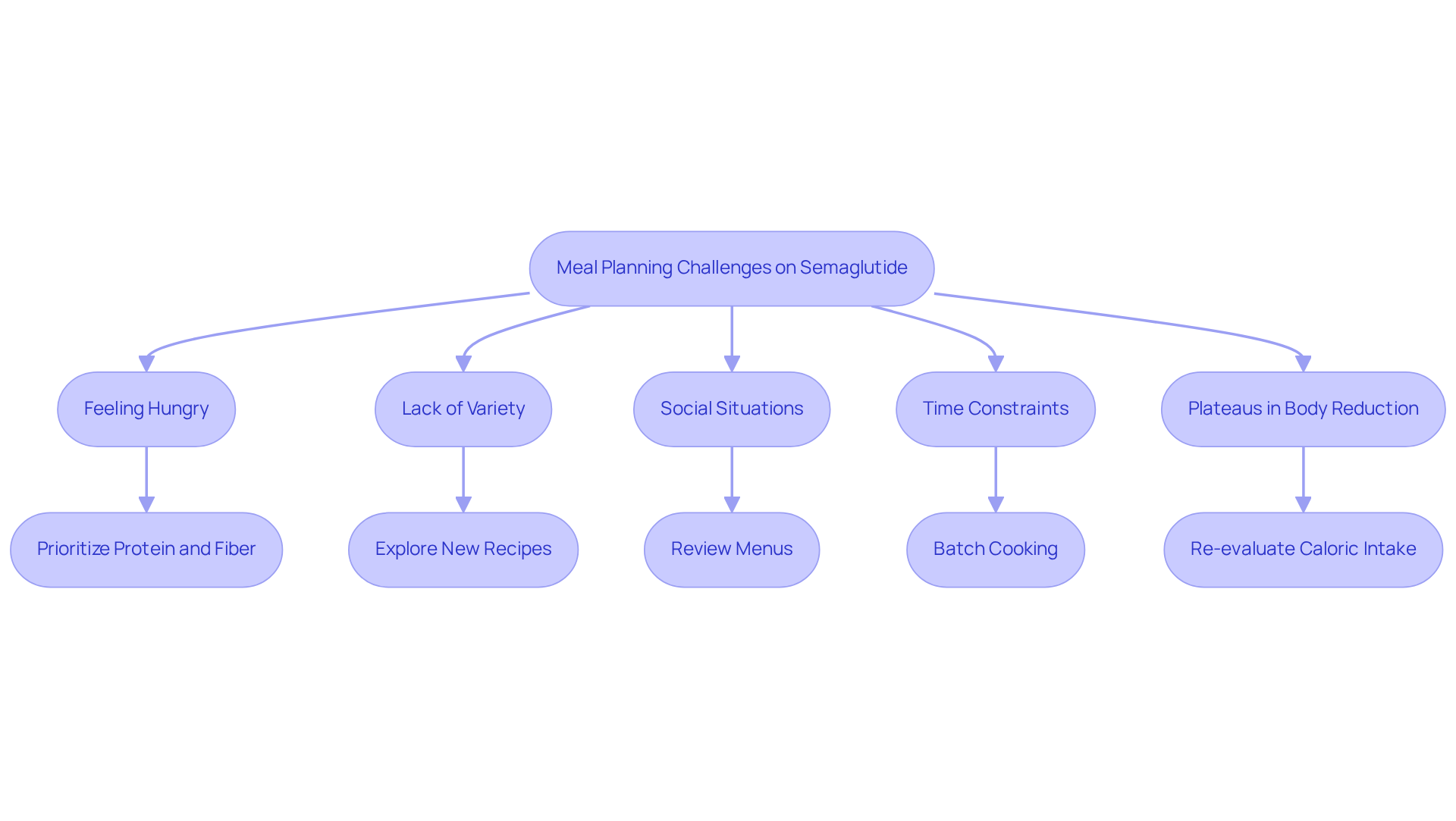Overview
This article presents four essential steps to help you create a sample meal plan while using semaglutide. We understand that navigating your weight loss journey can feel overwhelming, so we focus on the following:
- The medication’s benefits
- Identifying key food groups
- Crafting a personalized plan
- Addressing common challenges you may face
By incorporating lean proteins, non-starchy vegetables, whole grains, healthy fats, and fruits, you can effectively harness semaglutide’s appetite-regulating effects to support your weight loss goals. Together, we can navigate potential obstacles with practical strategies that empower you on this journey.
Introduction
Semaglutide has emerged as a groundbreaking solution for those grappling with weight loss, offering a unique approach to appetite regulation that can lead to substantial results. We understand that embarking on this journey can feel overwhelming, but by learning how this medication works alongside a tailored meal plan, you can unlock a pathway to healthier living and improved well-being.
However, the journey to effective meal planning on semaglutide is not without its challenges. How can you navigate hunger, maintain variety, and stay committed in social situations? Exploring these complexities not only reveals strategies for success but also highlights the potential for transformative change.
Understand Semaglutide and Its Benefits for Weight Loss
Semaglutide, a glucagon-like peptide-1 (GLP-1) receptor agonist, plays a crucial role in reducing body mass by effectively regulating appetite and enhancing feelings of fullness. By mimicking the action of a hormone that controls hunger, semaglutide leads to a notable reduction in food intake.
Have you ever felt overwhelmed by your weight loss journey? You’re not alone. Clinical studies have shown that individuals using semaglutide can achieve significant weight loss, with many participants shedding 15% or more of their body mass over time. For instance, a study involving 2,000 obese adults revealed that half of the participants lost at least 15% of their body mass after 68 weeks of treatment. Furthermore, clients of Minimal can lose up to 20% of their mass based on data from over 70,000 patients who have participated for at least six months.
This medication is typically prescribed alongside a sample meal plan on semaglutide, a reduced-calorie diet, and increased physical activity. It’s essential to create a sample meal plan on semaglutide that aligns with its appetite-regulating effects. As Dr. Priyom Bose observes, “Since the advantages of semaglutide are intrinsically linked to lifestyle changes, following a sample meal plan on semaglutide designed by nutritionists could significantly contribute to improved control of blood glucose levels, sustaining healthy cardiovascular function, and encouraging reduction in body mass.” Understanding how semaglutide works can empower you to make informed dietary choices and lifestyle changes that enhance your journey toward a healthier body.
However, it’s important to be aware of potential side effects, which may include dizziness, fatigue, and gastrointestinal issues. These can impact your experience while using the medication, but remember, we’re here for you. Together, we can navigate these challenges and work towards achieving your goals.
Identify Key Food Groups for Your Semaglutide Meal Plan
When crafting a sample meal plan on semaglutide, it’s important to focus on incorporating key food groups that not only support weight loss but also promote overall health. We understand that this journey can feel overwhelming, but taking it step by step can make a significant difference.
-
Lean Proteins: Consider incorporating sources such as chicken, turkey, fish, tofu, and legumes. Lean proteins are vital for maintaining muscle mass and promoting satiety, helping to curb hunger and reduce overall caloric intake. How do you feel about adding more protein to your meals?
-
Non-Starchy Vegetables: Fill your plate with leafy greens, broccoli, bell peppers, and zucchini. These vegetables are low in calories yet high in fiber and essential nutrients, making them a fantastic option for managing body composition. Remember, every small change counts!
-
Whole Grains: Opt for whole grains like quinoa, brown rice, and whole wheat bread. These grains provide essential carbohydrates and fiber, aiding digestion and helping you feel full longer—crucial for maintaining a caloric deficit. Together, we can make healthier choices that fit your lifestyle.
-
Healthy Fats: Include sources such as avocados, nuts, and olive oil in moderation. Nutritious fats are essential for overall well-being and can improve fullness, making it easier to stick to your dietary regimen. It’s all about balance!
-
Fruits: Choose whole fruits like berries, apples, and oranges. Rich in vitamins, minerals, and fiber, fruits can satisfy sweet cravings without hindering your weight loss goals. What are your favorite fruits that you can enjoy?
By concentrating on these food categories, you can create a balanced dietary plan that incorporates a sample meal plan on semaglutide, which not only aids your weight loss objectives but also promotes long-term health benefits. Regular check-ins with dietitians can further enhance your meal planning, ensuring that you maintain a healthy lifestyle and achieve sustainable results. In fact, studies indicate that clients can lose up to 20% of their mass based on data from over 70,000 patients who participated in similar programs. This underscores the importance of professional support in achieving and maintaining a 5-10% weight loss over 1-2 years, as emphasized by current clinical guidelines. Minimal’s comprehensive method, which merges medical, nutritional, and fitness knowledge, further boosts the efficiency of your dietary strategy. Remember, we’re here for you, and together, we can achieve your goals!
Craft Your Personalized Semaglutide Meal Plan
Creating your personalized sample meal plan on semaglutide can feel overwhelming, but by following these simple steps, you can take charge of your health journey.
-
Determine Your Caloric Needs: Start by calculating your daily caloric requirements based on your age, gender, body mass, height, and activity level. This calculation is essential for setting a target calorie consumption that supports your weight loss goals. Many clients find success, shedding up to 20% of their weight after just six months in the program. This highlights the importance of a well-organized dietary plan.
-
Organize Your Food: Aim for three balanced meals and two healthy snacks each day. Each meal should include lean protein, non-starchy vegetables, whole grains, and healthy fats. For instance:
- Breakfast: Scrambled eggs with spinach and a slice of whole-grain toast.
- Lunch: Grilled chicken salad with mixed greens, cherry tomatoes, and a vinaigrette dressing.
- Dinner: Baked salmon with quinoa and steamed broccoli.
- Snacks: Greek yogurt with berries or a handful of nuts. Remember, focusing on how you will feel after eating can enhance your intrinsic motivation.
-
Prepare a Grocery List: Based on your meal plan, create a grocery list to ensure you have all the necessary ingredients. This strategy helps you avoid impulse purchases and keeps you aligned with your health goals. Visualizing your goals can also help maintain your focus and commitment.
-
Prepare Food in Advance: To save time during the week, consider batch cooking. This not only simplifies sticking to your dietary plan but also reduces the temptation of unhealthy options. Pay attention to your hunger signals; it’s crucial not to deprive yourself, as this promotes sustainable weight loss.
-
Monitor Your Progress: Keep a log of your food intake and how you feel after eating. Adjust your food strategy as needed based on your hunger levels, energy, and progress. Remember, discipline is more sustainable than motivation, so cultivate a disciplined approach to your food planning.
By following these steps, you can create a sustainable dietary strategy that includes a sample meal plan on semaglutide to support your weight loss goals. Together, we can achieve a healthier lifestyle, and remember, you are not alone on this journey.
Troubleshoot Common Meal Planning Challenges on Semaglutide
Adhering to a sample meal plan on semaglutide can present various challenges, and it’s completely understandable to feel overwhelmed at times. Let’s explore some common issues you might encounter, along with effective strategies to help you navigate them with confidence.
-
Feeling Hungry: If hunger strikes between meals, consider prioritizing protein and fiber in your diet. Healthy snacks, like a piece of fruit or a small handful of nuts, can be a wonderful way to bridge the gap and keep you feeling satisfied.
-
Lack of Variety: Eating the same meals can lead to boredom, which is why it’s important to keep your diet exciting. Why not explore new recipes and cooking techniques? Experimenting with a variety of vegetables, spices, and whole grains can enhance both flavor and nutrition, making your meals more enjoyable.
-
Social Situations: Dining out or attending social gatherings can feel tricky, but with a little preparation, you can stay on track. Review menus in advance to identify healthier options, and don’t hesitate to bring your own snacks or food along—it’s a great way to ensure you stick to your plan.
-
Time Constraints: If food preparation feels overwhelming, consider batch cooking on weekends or utilizing quick-cooking methods like stir-frying or grilling. Healthy pre-packaged choices can also save you time while keeping your meals nutritious.
-
Plateaus in Body Reduction: Encountering a pause in body reduction can be frustrating. It may be time to reevaluate your caloric intake and activity levels. Adjusting portion sizes or increasing physical activity can help reignite your progress.
Remember, semaglutide is recommended by the FDA for individuals with a BMI of 27 kg/m² or greater with at least one weight-related condition, or a BMI of 30 kg/m² or greater. It’s also important to note that common side effects include gastrointestinal issues, which can often be managed by starting on a lower dose. As Vijaya Surampudi, a physician nutrition specialist, wisely points out, “Obesity is heterogeneous, chronic, and complex. There is no cure for obesity. It requires lifelong treatment that’s not one size fits all.”
By proactively addressing these challenges, you can stay committed to your sample meal plan on semaglutide and effectively pursue your weight loss goals. Together, we can achieve your goals, and we’re here for you every step of the way.
Conclusion
Creating a personalized meal plan on semaglutide is a significant step toward achieving your weight loss goals and enhancing your overall health. By understanding how semaglutide works and its appetite-regulating benefits, you can tailor your dietary choices to make the most of this medication. This approach not only supports weight management but also contributes to long-term health improvements.
This article outlines essential strategies for crafting a sample meal plan that includes key food groups such as:
- Lean proteins
- Non-starchy vegetables
- Whole grains
- Healthy fats
- Fruits
By focusing on these categories, you can create balanced meals that keep you feeling satisfied and nourished. Additionally, we provide practical tips for overcoming common meal planning challenges—like managing hunger, ensuring variety, and navigating social situations—to empower you to stay committed to your dietary goals.
Ultimately, your journey with semaglutide is not just about losing weight; it’s about embracing a sustainable lifestyle that nurtures your health and well-being. By adopting the meal planning strategies outlined, you can make significant progress. It’s crucial to prioritize healthy choices and seek support when needed. Taking these steps can lead to a more fulfilling and healthier life, reinforcing the belief that with dedication and the right tools, you can achieve your weight loss goals. Remember, we’re here for you, and together, we can achieve your goals.
Frequently Asked Questions
What is semaglutide and how does it work for weight loss?
Semaglutide is a glucagon-like peptide-1 (GLP-1) receptor agonist that helps reduce body mass by regulating appetite and enhancing feelings of fullness. It mimics a hormone that controls hunger, leading to a reduction in food intake.
How much weight can individuals expect to lose with semaglutide?
Clinical studies have shown that individuals using semaglutide can achieve significant weight loss, with many participants losing 15% or more of their body mass over time. For example, a study with 2,000 obese adults found that half lost at least 15% of their body mass after 68 weeks of treatment.
What additional lifestyle changes are recommended when using semaglutide?
Semaglutide is typically prescribed alongside a reduced-calorie diet, increased physical activity, and a sample meal plan designed to align with its appetite-regulating effects. These lifestyle changes are crucial for maximizing the benefits of the medication.
What are the potential side effects of semaglutide?
Potential side effects of semaglutide may include dizziness, fatigue, and gastrointestinal issues. These side effects can impact the experience of using the medication.
How can a sample meal plan on semaglutide help users?
A sample meal plan on semaglutide, designed by nutritionists, can significantly contribute to improved control of blood glucose levels, sustaining healthy cardiovascular function, and encouraging reduction in body mass, thus enhancing the overall weight loss journey.
What should individuals do if they experience side effects while using semaglutide?
If individuals experience side effects while using semaglutide, it is important to communicate these challenges to healthcare providers for support and guidance in navigating the medication’s effects.

